How do you use a PTFE syringe filter?
In today’s environment, rapid and simple sample preparation is a must. Our syringe filters are designed for higher flow rates and throughputs than those of competing products.
In this blog, we talk about the syringe filter from different aspects to help you know this product better.
What is a syringe filter?
Syringe filters are single-use membrane devices, attached to the end of a syringe. Used to remove particulate impurities from samples (liquid/gas) prior to some type of analysis to prevent damage to equipment (e.g. HPLC, chromatography ionic, ICP, dissolution tests, etc.)
A syringe filter usually consists of a housing with a membrane that serves as a filter (classified according to composition, filter diameter, and pore size). Both components must be compatible with the application and solution being filtered.
Proper sample filtration improves the quality and consistency of analytical results and reduces instrument downtime.
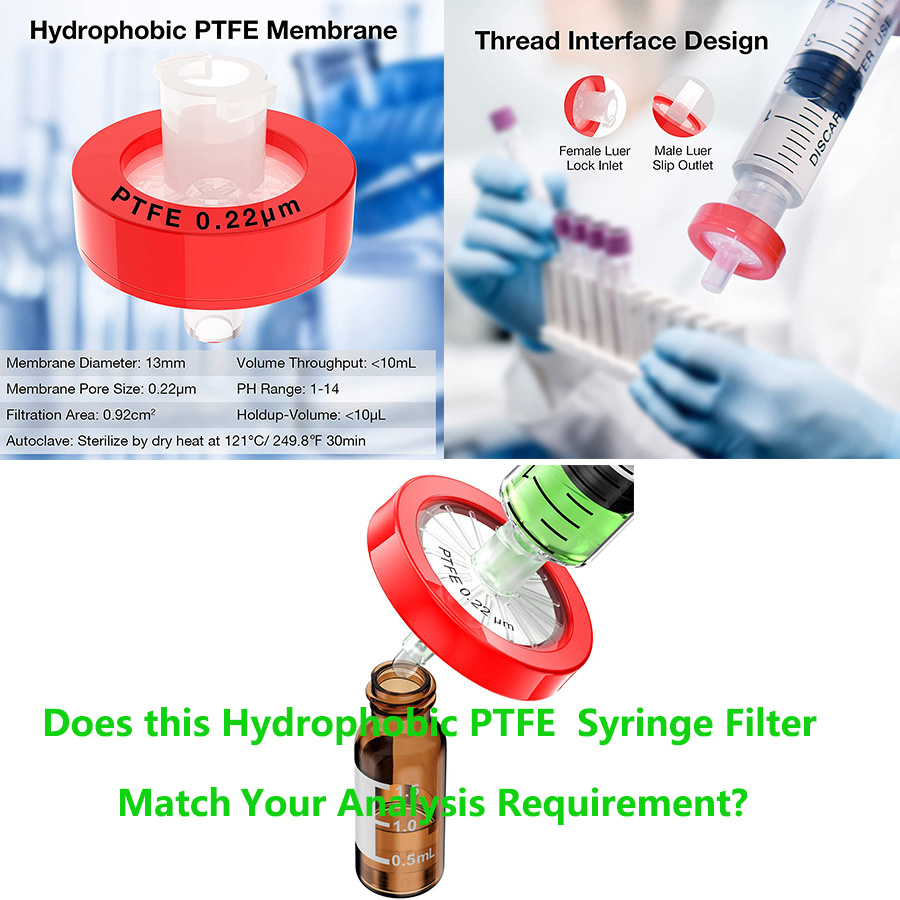
What are syringe filters used for?
Syringe filters can be used to remove particles from a sample before it is used in techniques involving expensive instruments that are easily damaged due to the narrow bore and high pressures inside.
Syringe filters are quite suitable for Schlenk line work, which makes extensive use of needles and syringes. They may be used for general purpose filtration, especially of smaller volumes where losses by soaking up filter paper are significant.
Syringe filters are also available for the filtration of gases, and for the removal of bacteria from a sample.
What size syringe filter do you need?
Syringe filters range in diameter from 4 mm to 50 mm. The larger the diameter, the more particles can be captured on the filter surface before it begins to block, leading to back pressure and the force that must be applied to the syringe plunger to extract the purified material.
The size of the syringe filter is up to the diameter of the membrane filter inside of it. There is 4 kind of the main size in the market which are 4mm, 13mm, 25mm, and 33mm. The diameter of the membrane also directly affects the number of reagents that the filter can filter. Please refer to the information below to compare the amount of filtration solvent corresponding to the four membrane diameters.
| Choosing the Proper Diameter | |
| Filter Diameter | Volume |
| 4mm | <1ml |
| 13mm | 1-10ml |
| 25mm | 10-100ml |
| 33mm | >100ml Fast Filtration |
Which syringe filters should I use?
1. Cellulose Acetate (CA)
Cellulose acetate is a very low protein binding membrane that is ideal for aqueous-based samples and biological samples. It is a lower protein binder than either polyethersulphone or PVDF membranes but has a lower chemical resistance than regenerated cellulose (RC). CA is a strong membrane mechanically and hydrophilic.
2. Glass fiber (GF)
Glass Microfibre filters should be used as a pre-filter for samples with high particulate content. GMF membranes are available with a higher pore size than other membranes and are tolerant to most solvents.
3. Nylon (NY)
Nylon membrane has high strong mechanical strength, and chemical stability, can be tolerated by most organic solvents, is extremely low in extractable, has good thermal stability (up to 50°C), is naturally hydrophilic and the majority of water solution filter characteristics. It is more often applied to the common organic solvent HPLC mobile phase filtering.
4. Polyethersulphone (PES)
Polyethersulphone is a hydrophilic membrane that has very low protein binding and high flow characteristics. It is also certified for ion chromatography. Polyethersulphone is more heat resistant than most membranes and can be used to 100℃.
5. Polypropylene (PP)
Hydrophilic polypropylene membranes are chemically resistant and suitable for a wide variety of organic and aqueous-based samples. They are low protein binders and can be used with strong acids and bases without prewetting.
6. Polytetrafluoroethylene (PTFE)
PTFE membranes are chemically resistant to nearly all solvents, acids, and bases. The membrane has low extractability and good thermal stability. PTFE is hydrophobic and requires pre-wetting prior to use with aqueous solvents.
7. Polyvinylidene Difluoride (PVDF)
Polyvinylidene difluoride is a hydrophilic membrane that is suitable for most general biological sample filtration. It has broad chemical compatibility and is a low protein binder and so a good choice where high protein recovery is required.
8. Regenerated Cellulose (RC)
Regenerated cellulose is a hydrophilic solvent-resistant membrane. It is a very low protein binder and is ideal for low nonspecific binding applications; tissue culture media filtration and general biological sample filtration.
How do I choose a syringe filter?
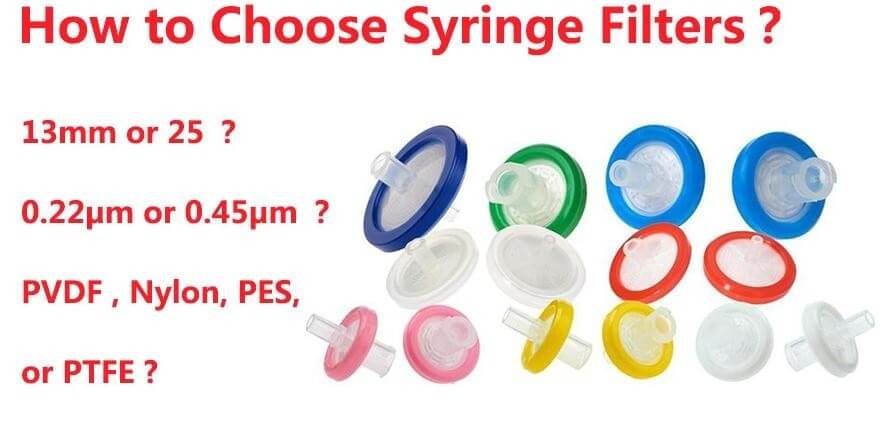
There are two aspects to consider when selecting a syringe filter. Let’s look at some of the most important:
Aperture
Filters have different apertures. Common ones are 0.2um and 0.45um. Most programs typically use a 0.45um filter. However, if there are very fine particles in the sample, it is advisable to use particles of 0.2 or even 0.1um. It is important to note that there are other ways to filter very small particles, such as centrifugal filters, which may be a better choice.
Filter material
Needle filters are also available in a variety of filter materials. Cellulose acetate, polyethersulfone, and polyamide are just some of the common ones. In addition, they have certain compatibility, so be sure to choose carefully. The material will also affect the EFA or effective filtration area and will also affect the capacity.
Filter size
As particles accumulate over time, they can clog pores and eventually disable filters. That’s why it’s important to choose a syringe filter that can hold more fluid. In general, larger diameter filters have higher retention volumes. Retention is the amount of liquid left after using the filter. It is also recommended that smaller diameter filters be used with rare and expensive fluids.
What are the components of a PTFE syringe filter?
These syringe filters typically have filter media of hydrophobic PTFE and are housed in glass-reinforced polypropylene. For higher filtering precision, some of these syringe filters come with a male Luer slip outlet and a female Luer lock inlet. Designed to give your research the highest levels of purity and performance a PTFE syringe filter is gas-sterilizable, non-sterile, or autoclavable. Polytetrafluoroethylene syringe filters are incorporated with different types of membranes so as to offer the highest levels of separation and purification. Each unit usually contains two pre-filters that allow difficult or highly aggressive samples to be easily filtered without causing any corrosion to the unit. They are designed in a way that requires minimum manual effort.
How to use a PTFE syringe filter?
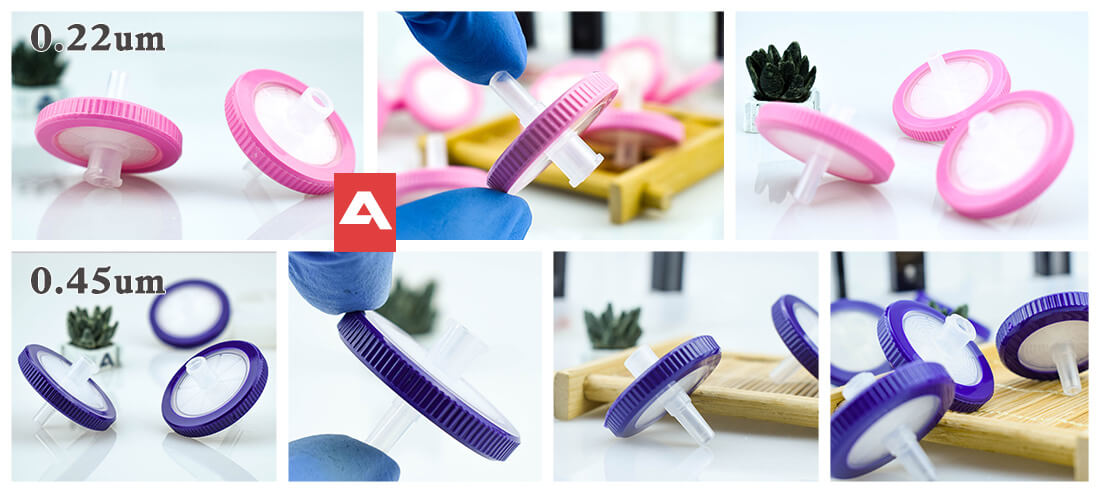
- Fill the syringe with the solution to be filtered.
- Fasten the filled syringe to the FLL inlet of the syringe filter with a twisting motion.
- With the outlet pointed upward, gradually apply pressure to the syringe plunger to initiate flow.
- Continue thumb pressure until all the air in the device is displaced with liquid.
- Once the liquid starts to exit the syringe fitter outlet, stop applying pressure, and point the device downward and away from the user.
- Position syringe filter over suitable collection container or other apparatus and apply pressure again to filter sample. Change filters when flow becomes too slow or resistance becomes excessive.
When you are concerned about contamination, the process is very similar, but there are other steps that need to be performed before taking a sample:
1. Use the most appropriate filter.
2. Soak up 1ml of air cushion, then soak up 10ml of the blank matrix (e.g. mili-Q or 1% nitric acid).
3. Eject the substrate and air cushion into the waste container.
In Conclusion
Aijiren has the best microfiltration products in the market and works with the best names in this field. Choose your PTFE syringe filter from our wide range of quality lab products. When you opt for the best filtration products, you stand to benefit your research, the end result of your study as well as the numerous people towards whom your research is aimed.
Back to List
-
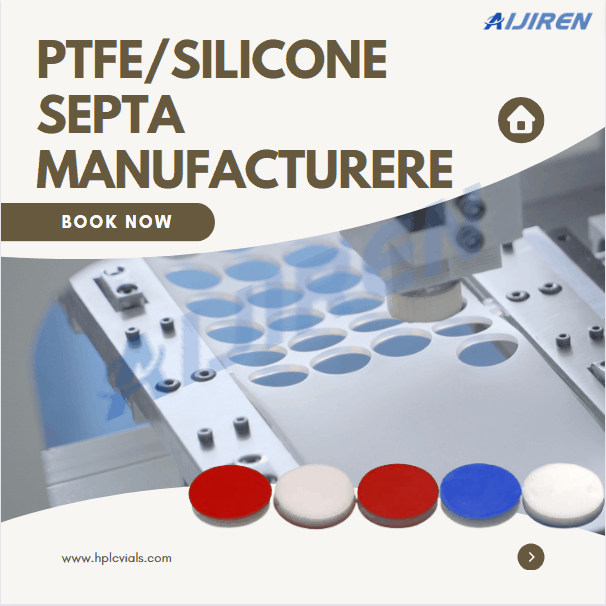 下午4:09Weighing the Pros and Cons of PTFE/Silicone Septa
下午4:09Weighing the Pros and Cons of PTFE/Silicone Septa -
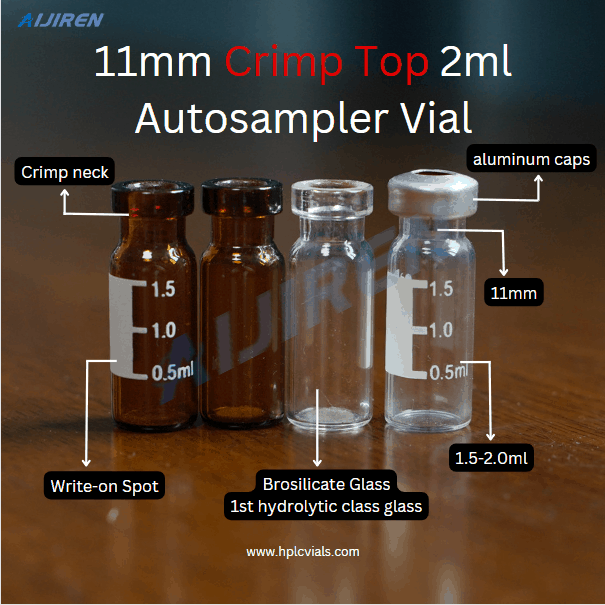 下午4:05Decoding Vial Discard Guidelines: Ensuring Precision in Chromatography
下午4:05Decoding Vial Discard Guidelines: Ensuring Precision in Chromatography -
 下午5:01Navigating Micro Inserts for HPLC Vials: A Comprehensive Guide
下午5:01Navigating Micro Inserts for HPLC Vials: A Comprehensive Guide -
.jpg) 下午2:02Common faults and solutions of automatic samplers(2)
下午2:02Common faults and solutions of automatic samplers(2) -
 下午5:08Ensuring Sample Integrity: Navigating EPA Storage Vials Stability Guidelines
下午5:08Ensuring Sample Integrity: Navigating EPA Storage Vials Stability Guidelines

